This post is really a tale of two Overholsers — Father and Son. After finishing my research on Oklahoma City’s 16th mayor, Edward Overholser, I concluded that it would be impossible to tell Ed’s story without speaking to Henry’s story, too. So, be prepared to meander something like the downtown North Canadian River once did. I’ll try to tie it all together by the end. Here we go!
In this revised post, click on any image for a larger view.
HENRY — "The Father of Oklahoma City". Henry was the 1st to arrive, coming by train within a few days following the April 22, 1889, Land Run, and he is often referred to as "The Father of Oklahoma City."
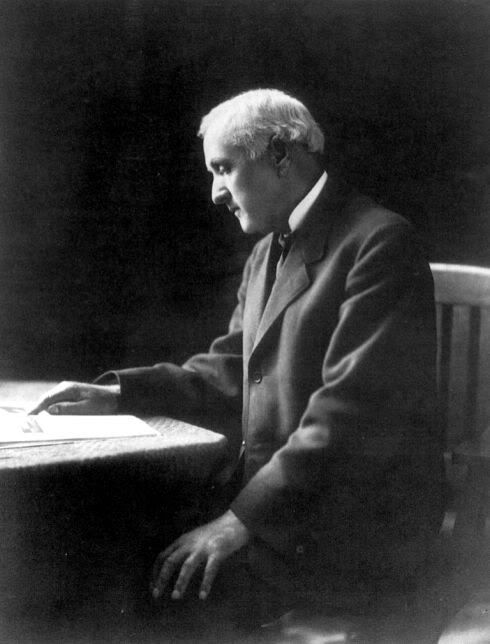
From www.okhistory.org, we learn that Henry was born in Ohio (1846), became wealthy as he had business successes in Indiana, Colorado, and Wisconsin before arriving in Oklahoma City on or a few days after the Land Run of 1889, where he remained until his death in 1915. While in Indiana, he married, had two children (Edward 1869-1931; and Elizabeth [died in Kansas in 1918 — see the note below as to her name]), and was divorced around 1880. No standard internet references I’ve found (e.g., the Oklahoman and not even Oklahoma Historical Society bios and/or obits) identify the name of Henry's first wife and mother of the Edward and Elizabeth (or Queen — see below).
However, a great-great-great-nephew of Henry and great-great-nephew of Edward Overholser kindly helps fill in the gaps. The nephew is a direct descendant of Levi (aka Lee) Overholser, Henry's brother, who came to Oklahoma City shortly after Henry and who died in 1905. The ancestor (who prefers to remain anonymous) informs as follows:
I looked through my files a little more thoroughly, and it looks like Edward's mother's name was Emma R. Hannah. That's what the records of the Overholser Family Association call her; their record says she was born circa 1849 in Indiana. The 1880 census lists Emma and her kids with her mother, Elizabeth Hannah, in Brazil, Indiana. Emma is listed as 29 years old and divorced. The census record doesn't give her a last name, which would imply that it's the same as her mother's one line above. Perhaps she dropped her married name, or perhaps it was just a mistake. Below her are children Edward Overholser, 10, and Elizabeth Overholser, 8. Well, the transcriber read it as "Overhetzen," but close enough.For much more information about the Overholser family, see the blog maintained by Edward's great-great-great-nephew and Edward's great-great-grand-nephew and Levi's great-great-great grandson at here and here.
By the way, the name Elizabeth didn't sound right to me for Edward's sister. The name I remembered was "Queen." Sure enough, I found online a probate record for "Queen E. Pirtle" who died in Kansas in 1918 and was "at the time of her death the owner of an undivided 1/3 interest in the estate of Henry Overholser, dec'd." per this source. So perhaps her name was "Queen Elizabeth Overholser?" Well, we do know that there is a strain of pretension in the family!
Within six months of arriving in Oklahoma City, Henry (age 43) married Anna Ione Murphy (age 18, 1872-1940), daughter of Samuel Murphy, lawyer and the first Oklahoma territorial treasurer — which means that Edward's beautiful step-mother was about 3 years his junior in age!
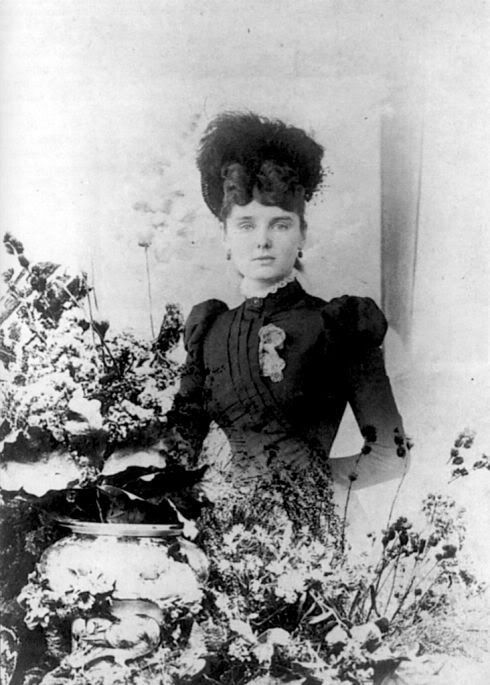
Henry and Ione had one child, a daughter named Henry Ione (1904-1954) (yes, Henry). In 1903 before the daughter was born, they built this stately home at 405 NW 15th in 1903 (now owned by the Oklahoma Historical Society and open to the public):
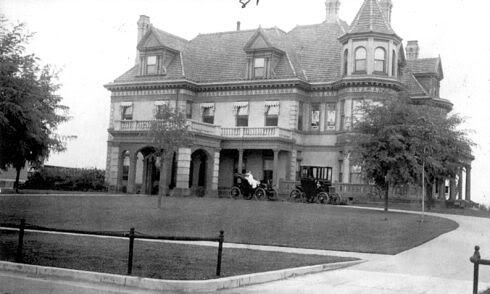

The Overholser Mansion Today
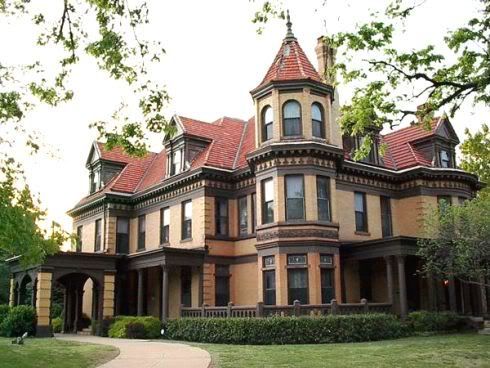
EDWARD. Edward was our 16th mayor (April 13, 1915 - December 24, 1918). He was born on June 20, 1869, in Sullivan, Indiana.

As I said above, no written biography I’ve located (including scholarly articles such as this one published in OHS’s Chronicles of Oklahoma) identifies Edward’s mother. Same thing here. Personally, I’d call that bad history writing – Henry’s wife and Edward’s mother wasn’t a non-person, was she? Not at all, per the contribution of a family member, above. Her name was Emma.
Ed (as he was usually called) followed his father to Oklahoma City in 1890, after completing four years as a student at the University of Wisconsin, at the age of 20 or 21. Here, he married Allie Garrison, daughter of George Garrison (the last elected Sheriff of Oklahoma County prior to Statehood). Two children were born to them — one died in infancy; the other, a son, Edward Jr., and his widow, survived him. They resided in the family residence, 1001 Northwest 17th Street, Oklahoma City, built in 1910. According to the County Assessor’s records, the home’s size is 3,396 square feet and is privately owned. I took the pictures below in 2006:
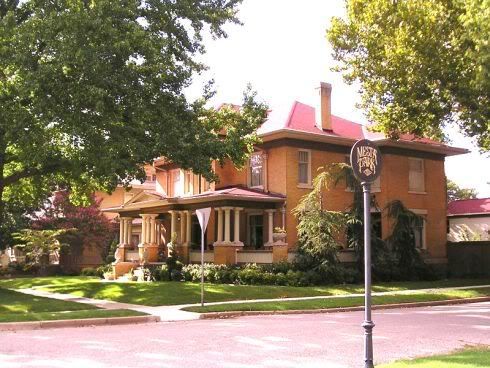
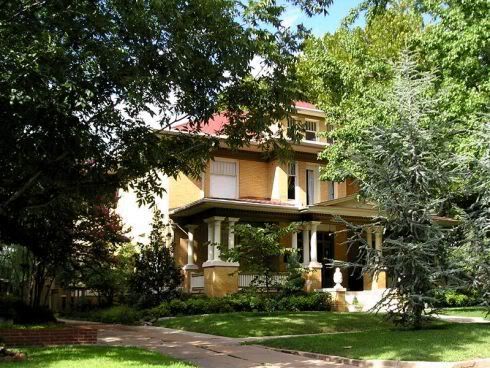
AFTER FATHER & SON ARRIVED IN OKC . . .
What did Henry Do? He made money, and he made lots of it, no disrespect intended — because, in that process, he was responsible for a substantial portion of the immediate and forthcoming growth and development of the city as well as providing jobs for many along the way. By the end of his life, it is said that he may have become the wealthiest person in Oklahoma.
Henry came to Oklahoma City prepared to make money — contemporaneous with his arrival, several carloads of prefabricated wood-frame buildings he purchased in Michigan preceded him. When the picture below was taken on Grand (Sheridan), only a month had passed since the Land Run:
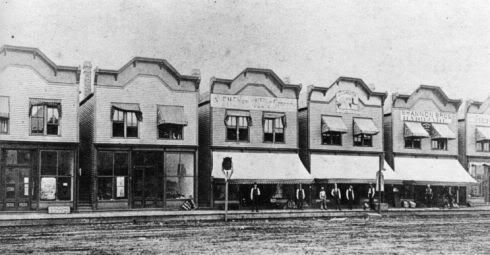
He was also involved with ventures that persuaded two large meat packers to locate in Oklahoma City, covered in the Packingtown article, and with the development of railroads. The image below, probably taken between 1893 and 1897, shows the Board of Trustees of the St. Louis & Oklahoma City Railroad, including Henry in the upper left corner:
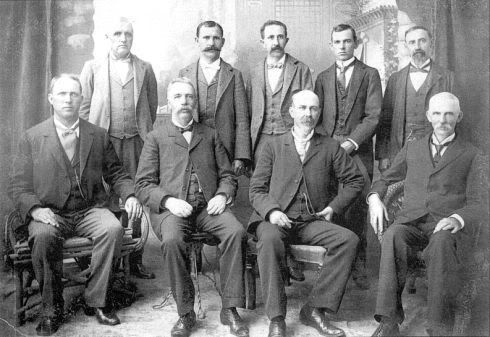
Pictured in the above, back to front, left to right, are:
Henry Overholser, J.M. Owen, Judge S.A. Steward, F.L. Dobbin, & F.M. Rile
C.G. Jones, Henry Wills, T.M. Richardson, & Judge Sidney Clark
According to this source:
Within a few days of arriving, Overholser erected six business buildings on lots he purchased on Grand (now Sheridan) Avenue [ed. note: see above], and within a month he was elected president of the new Board of Trade, precursor to the Oklahoma City Chamber of Commerce. Twice running unsuccessfully for mayor, Overholser was elected to the Oklahoma County Commission in 1894.What Did Edward Do? The "early" record, after Ed migrated to Oklahoma City in 1890 when he was 20-21, is less clear — the Oklahoman’s on-line archives start in 1900. But, we do know that Ed became the manager of the Overholser Opera House and at sometime prior to 1904 became a county commissioner, even though I’d suppose this brief rendering only to be only to be the tip of the iceberg. But, reviewing what I have so far, it does appear that "What did Edward do" most probably falls within his term as Oklahoma City mayor, discussed later in this article.
Overholser used his skill and wealth to encourage new business by investing in capital improvements and by creating agricultural services to draw farmers to the new town. In 1895 he and C.G. Jones organized the Saint Louis and Oklahoma City Railroad, which began service in 1897 and linked Oklahoma City to Tulsa, Kansas City, and St. Louis via the Frisco line. At about the same time Overholser was instrumental in promoting a street car line for the city. At the turn of the century the local economy was booming and the population had tripled, due in large part to his efforts.
He was a firm believer in providing services and entertainment for the public. In 1889 he built the Grand Avenue Hotel. In 1890 he erected the magnificent Overholser Opera House on Grand Avenue, followed by the Overholser Theater at Grand and Robinson. In 1906 he helped the Chamber of Commerce purchase grounds at 10th and Eastern for a permanent home for the State Fair of Oklahoma, and he served many years on the Fair Board.
UNCLE HENRY, ED, & THE DAILY OKLAHOMAN. From what I’ve read in the Daily Oklahoman's archives (and assuming that it is at least half-accurate), Henry wanted power. He wanted to be mayor but he never got there. The period around ten-eleven years before his death, during 1904-1905, is particularly revealing. These descriptions also involve our mayor, Ed, before he was that, and some of the other players just mentioned. It is also noted that during this 1904-1905 span, E.K. Gaylord was only a part owner of the Daily Oklahoman. E.K. didn’t migrate to Oklahoma until 1903, and the Daily Oklahoman was established earlier, around 1889 by Samuel Small. Here’s an 1896 image when located at 26 West Main:
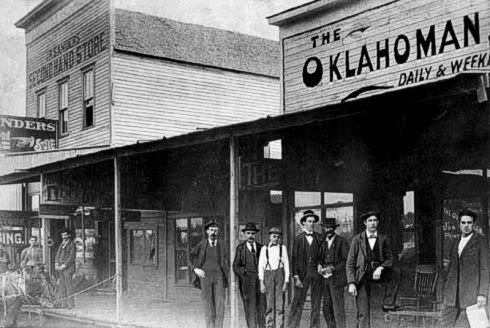
IMPORTANT ASIDE: If you have an Oklahoma City Metropolitan Library Card (which costs you nothing to get), you can log on to its website wherever you may be and then access lots of archived databases, including the Oklahoman archives, for free. So, get yourself a Library Card and have a more particular look at history!By 1894, Henry had twice run for mayor, losing both times. But, he was elected to the Oklahoma County Commission in 1894. The Daily Oklahoman’s attitude and descriptions during the 1904-05 period are particularly interesting — both as to Henry and Ed, but also to the Daily Oklahoman’s posture during that time. In that time, the Oklahoman was considered to be a pro-labor, pro-Democrat Party, newspaper, which is to say, anti-capitalist, anti-Republican Party!
In 1904, after Lee Van Winkle’s 1903 election as mayor, Henry went thorough legal machinations to thwart that election and attempt to have himself declared the mayor. The Oklahoman’s archives (5/3/1904) report that,
In the district court yesterday morning Judge J.L. Pancoast presided at the hearing of the application of Henry Overholser for a writ of mandamus to oust Mayor Van Winkle from office, which application after hearing the arguments the court last night denied.The next day,4/28/1904, the Oklahoman's headline read, "Asked For Mandamus — Overholser Is Still Desirous Of Snatching the Mayor’s Office Forthwith". Part of the article’s text reads,
Immediately after the convening of district court for the night session last night, Attorneys Fulton & Paul and Hays, Thorp & Thorp, for Henry Overholser, filed a peremptory mandamus against Mayor Lee Van Winkle demanding possession of the mayor’s office, appurtenances, etc. The writ of mandamus comes immediately upon the supersedeas granted by Judge Hainer stating the injunction by Mr. Van Winkle directing Mr. Overholser to not in any way interfere with the peaceful possession of the office. * * *Without belaboring the point, Henry Overholser lost the legal maneuvering and Van Winkle prevailed.
But, that was not the end of that! In January 1905, Henry’s son, Edward, then a county commissioner, announced his resignation. The Oklahoman's headline reads, "Overholser Out". Part of the text of the 1/20/05 article reads:
Ed Overholser has tendered to Governor Ferguson his resignation as county commissioner, and Henry Overholser says that Sam Miller will be appointed as Ed’s successor.The next morning’s Oklahoman ran an article called, "Overholser Machinations," reading, in part:
Some of the leading business men and politicians of Oklahoma City object, however, to the Overholsers naming who shall be the successor to this position, which resulted in a large delegation of Oklahoma City business men going to Guthrie yesterday morning to intercede with the governor that the naming of Mr. Overholser’s successor be left, not entirely to the Overholsers.
Having heard of the rumor that Ed Overholser intended to resign as county commissioner, a certain prominent business man of Oklahoma City called at Mr. Overholser’s office Wednesday to ascertain if there was any truth in the rumor, and probably make some suggestions regarding who might be a good man for the governor to appoint as his successor.
Ed Overholser was not in his office when this gentleman called, but the father of the commissioner, Mr. Henry Overholser, was at his desk.
Henry Overholser stated in reply to an inquiry that "Eddie has decided to resign and Sam Miller is going to be appointed in his place. I have fixed this matter up, and Mr. Miller will be appointed by the governor in the morning as Eddie’s successor."
Continuing, Henry Overholser, in substance, had the following to say regarding local politics with this same gentleman:
"I have decided to let C.G. Jones be the next mayor of this city, and I am to be councilman from the second ward and to be president of the council and dictate the policy of that body. Mr. Jones won’t have anything to do with the council at all; I will attend to that."
Mr. Overholser failed to state how he intended to work all these things and by what power he was dictating the policy of his party.
* * * there is now a general impression that Henry Overholser will put the boy (Ed) up as a candidate for the office of mayor. The prospect is an ill-tasting pill to many republicans who declare that the time has come to free the republican party in Oklahoma City from Overholser dominance.A week later, January 27, 1905, the Oklahoman reported that the Governor had appointed John A. Johnson to replace Ed Overholser as commissioner and not Henry’s hand picked man. But, the story does not end there. A week later, on February 4, Mr. Johnson resigned — turns out he didn’t live in the district for which he was appointed — and Ed Overholser was reappointed to the office he’d resigned from only a couple of weeks earlier! The Oklahoman's sub-headline reads: "Will His Family Suffer? In Resigning Said He Did So to Make a Living for His Family — Joke of the Year." In the article, a hypothesis is offered:
A leading republican said yesterday: * * * "It remains to be seen if our city is to be ruled by moneybags. If the Overholsers secure control of municipal affairs you will see an appalling expenditure of money to enhance the value of the Overholser real estate holdings and the rest of us will pay the bills and hold the sack."
* * * the most reasonable theory offered is that, after Ed had resigned, Uncle Henry became aware of the fact that his son had no more chance of election to the office of mayor than has a snowflake of maintaining its individuality in a hot teapot. With this knowledge came the information that in case Johnson could not accept the job, Merrill would be appointed. This was more than Uncle Henry could stand and the result is that there is again four members of the board of county commissioners and Uncle Henry is again the chairman.On April 1, 1905, the Oklahoman's front page headline looked like this:
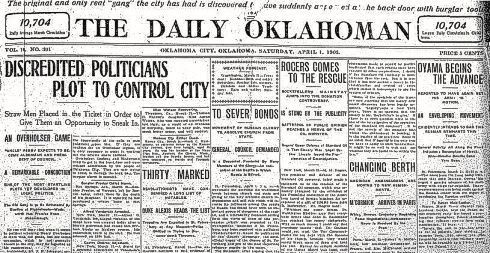
And Here's The Story (which I've cut and pasted into the form shown below)
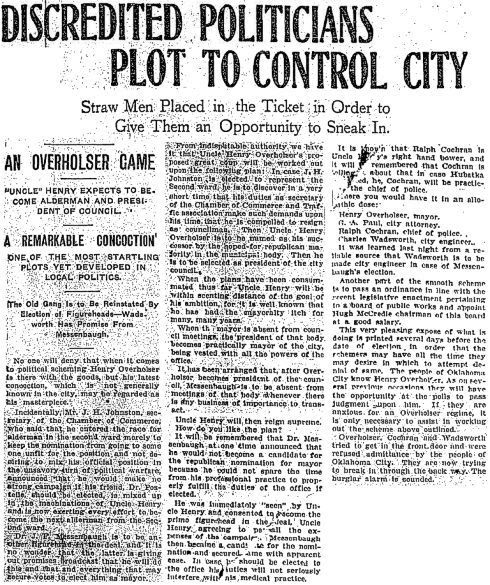
The smaller headline reads, "Straw Men Placed in the Ticket in Order to Give Them An Opportunity to Sneak In." This story wasn’t so much about what was described above – it was about another "scheme" the muckraking Oklahoman "uncovered" which was designed (by a convoluted series of events) for "Uncle Henry" to become mayor, according to the Oklahoman. Part of the article’s text reads:
No one will deny that when it comes to political scheming Henry Overholser is there with the goods, but his latest concoction, which is not generally known in the city, may be regarded as his masterpiece.Despite the "exposé", or (who can say) perhaps because of it, the republican ticket won the April 4, 1905, city elections by a landslide, including the election of J.F. Messenbaugh as mayor (said by the Oklahoman to be Henry Overholser’s man).
* * *
This very pleasing expose of what is doing is printed several days before the date of the election in order that the schemers may have all the time they may desire in which to attempt denial of same. The people of Oklahoma City know Henry Overholser. As on several previous occasions they will have the opportunity at the polls to pass judgment upon him. It they are anxious for an Overholser regime, it is only necessary to assist in working out the scheme above outlined.
Overholser, Cochran and Wadsworth tried to get in the front door and were refused admittance by the people of Oklahoma City. They are now trying to break in through the back way. The burglar alarm is sounded.
FAST FORWARD TO 1915: HENRY DIES, EDWARD IS ELECTED. By 1915, E.K. Gaylord owned the Oklahoman outright and had constructed new facilities at NW 4th and Broadway. Searching the Oklahoman's archives for the 1915 city elections turned up nothing like the 1904-1905 stuff. No muckraking, no exposed schemes, nothing at all "fun" was I able to discover. The mayoral candidates even all got together for a "Brotherhood Dinner" at the 1st Methodist Church before the primary election in March and where’s the fun in that? Perhaps the only thing even mildly interesting that I could find was that Lee Van Winkle who crossed swords with Henry in 1904 was again a democratic candidate, as was W.D. Gault whose father, W.J. Gault, had defeated Henry for mayor in 1890. This time, a Republican Overholser defeated a Democrat Gault by 327 votes, 3,912 to 3,391. Ed served as mayor from April 13, 1915, until he resigned on December 24, 1918, for health reasons.
Shortly after Ed’s election, his father died. The Oklahoman’s August 25, 1915, front page carried the story with the headline, "City’s Greatest Townbuilder Dies." This kinder-gentler Oklahoman makes no reference to the stuff written in 1904-05 but instead cites his many major contributions to the city’s development. The article’s closing paragraph reads,
In every public movement in the history of Oklahoma City Henry Overholser’s support was always for the right and forever against the wrong. Of rugged disposition, he lent his forceful character to the upbuilding of the Oklahoma City of the present.What a difference a few years makes!
Perhaps the most notable accomplishment of Mayor Overholser was his steadfast and successful lobbying for the city reservoir we know as Lake Overholser. Though some articles (including the OHS article, below) say that the reservoir and dam were named for Ed, it appears that the lake was, in fact, named for both the father and the son. Part of a December 24, 1918, Oklahoman article reads,
In recognition of the service of Mr. [Ed] Overholser, both as mayor and as a private citizen, and the services of his father, Henry Overholser, the city commissioners voted to name the lake at the new city waterworks Lake Overholser.
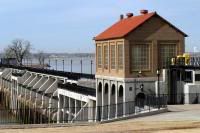
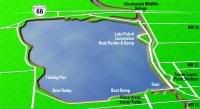
In a July 13, 1915, Oklahoman article, the Mayor is quoted:
"We must have this water sometime so why not get it now? Of course you may point to the fact that at the present time the North Canadian river is flooded and that we will have all of the water that we will need this year. Of course that is true but at the same time there is a next year coming and like years in the past it is liable to bring a water famine especially if Oklahoma City continues to grow as it has during the past twelve months."The mayor was also heavily involved in getting major meat packing plants to locate in Oklahoma City, all of which, of course, are now gone. Articles also note that he was heavily involved in "cleaning up" the city of some of its coarser elements.
On the lighter side, the December 8, 1918, Oklahoman's (not front page) headline read, "Mayor Turns Traffic Cop, Catches Two."
Mayor Ed Overholser last night hurriedly commissioned himself a traffic cop when a motor car whizzed past his automobile.I hope that Mayor Mick isn't reading this!
"If the police can't catch those speeders, I'll do it myself," he said, and turned in after the car.
Running beside the speeders down Broadway, Mayor Overholser says his speedometer showed 35 miles an hour. He shouted to the occupants of the car to accompany him to the police station. Their reply was to turn off on First street.
"You know how rough First street is," the mayor said later. "Well, we did 40 miles an our down First street to Harvey. There the car turned north to Fourth, speeded past a street car discharging passengers and, going 40 miles an hour, narrowly missed another automobile.
"Going west on Fourth street, we were clipping off 45 miles an hour when I fire a shot from a pistol into the air and the driver then turned on Classen and slowed down.
Two of the occupants of the car, all of whom were boys, ran and escaped. The mayor took two others to the police station.
Following his December 24, 1918, resignation, a December 29 editorial in the Oklahoman shows how the newspaper’s perspective had changed since the 1905 era:
* * *And the highest compliment than can be paid Ed Overholser can be said in four words – "Like father, like son."This time, it was meant as a compliment.
His health recovering, he was for many years the president and manager of the Oklahoma City Chamber of Commerce, positions he held upon his death, April 21, 1931. His funeral was in the First Methodist Church, even though he was a member of the English Lutheran Church. The Oklahoman said that his pall bearers were friends: John R. Boardman, C.F. Colcord, Dr. Walter H. Dersch, Walter C. Dean, Stanley Draper, R.J. Edwards, E.K. Gaylord, Hubert Hudson, Ed Kelly of El Reno, Carl C.Agee, G.A. Hichols, J.F. Owens, Jack Tolbert, Ed S. Vaught, and Lew Wentz. For more about Ed Overholser, see this article in the Chronicles of Oklahoma.














6 comments:
Thanks for writing about the Overholsers. As you saw in my comment over at Dustbury, Henry O was my great-great-great uncle. I have some family history info that says Ed's mother was Emma Hannah McLain. I'll have to check the source for sure, though. The surname would make some sense, because Ed's full name was Edward Graham McLain Overholser. That first marriage ended in divorce before Henry came to Oklahoma.
Mark,
Thank you SO MUCH for posting ... I just noticed your post and I'm sorry if it has be "up there" for quite a time and I did not notice. Unfortunately, posts are not "date" stamped ... I'll see if I can fix that. But, if your post just follows the Dustbury post about the State Fair, then I'm pretty much up to snuff on timeliness.
Yes, I read and enjoyed your Dustbury post about the State Fair and how Henry Overholser was the State Fair's "father" benefactor ... I just didn't see that info on the internet and it is clear from reading a little that Henry Overholser and CG Jones had a good bit of business, if not personal, interrelationships.
But, your post's info about Henry's ex-wife and Edward's mother has got to be a FIRST! If you are able to confirm that Ed's mother was Emma Hanna McLain, I'd certainly want to post it because (I think) parentage info should be father/mother for history purposes.
Thanks again for your very nice and useful post! Edward's house is about 5 blocks from where I live and Henry's, of course, is an Oklahoma City landmark, not very many blocks further away!
If you'd prefer to communicate less publically about any of the above, my e-mail address is loudenbk@swbell.net.
Thanks again, very very much.
Mark,
One more thing which I forgot to say ... if you have ANYTHING which you'd care to contribute to this post about your "uncles" (both or either of them) which fits into the context of the main post, I'd be delighted to have the info and would certainly credit you (unless you wouldn't want to be) with the information. The most fascinating item I observed, between the 1905 and 1915 and later time period, is the Daily Oklahoman's perspective transformation ... from a non-family member, that was just plain fun stuff! I hope that it was fun for you, as well.
This is all very interesting! I am Ed Overholser's great-great grandaughter. Edward Jr.'s daughter is my grandmother. It's nice to see all the research you have done.
Thanks, daireth.
If you haven't already done so and if you are interested in communicating with "Mark," per the previous comments, click the bold-blue "Doug Dawg" at the top of this comment and send me an e-mail.
MYSTERY SOLVED!
Here is the graves for Henry's first wife Emma R. and his first daughter Queen E. Pirtle.
They are buried next to each other. Looks like Emma died with a last name of Sherman in 1912 and indeed she was born in 1849.
Queen was born in 1871 and died in 1918 at the age of 46 or 47.
Henry's daughters both died young.
http://www.findagrave.com/cgi-bin/fg.cgi?page=gr&GSln=pirtle&GSfn=queen&GSbyrel=all&GSdyrel=all&GSob=n&GRid=17278338&df=all&
Post a Comment